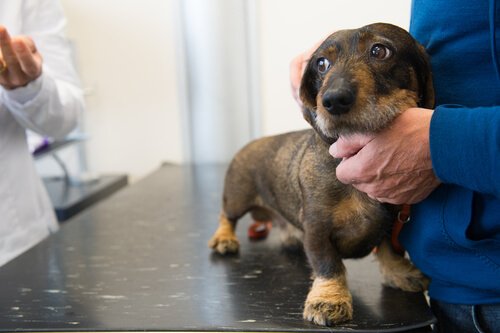Mange in Dogs


Written and verified by the lawyer Francisco María García
Mange is one of the most common health issues that affect dogs. If you suspect your dog has it, you should get him to the veterinarian right away to be examined and treated. Mange is caused by microscopic mites that live on their skin. Generally speaking, there are two types of mange in dogs.
Demodectic Mange
The parasite responsible for demodectic mange is called Demodex canis. It’s a microorganism and lives on the dog’s dermis and epidermis. However, when this mite begins to reproduce uncontrollably, complications arise.
Demodectic mange can manifest in two ways:
- Local: affects only small areas of the skin, usually on the face. Something like pimples appear and make the hair around it fall off.
- Generalized: as the name implies, this type of mange in dogs can affect any area of the animal’s epidermis.
Puppies up to six months old are usually the most affected.

Redness and severe inflammation of the skin, accompanied by hair loss, happen on a large scale. These are the most obvious symptoms. In the most severe cases, abnormal secretion and foul odors may come from the dog’s wounds. It affects dogs of any age.
Both types are accompanied by the typical feature of this disease: itching. The constant itching only accentuates the vicious cycle and perpetuates it. It’s quite bothersome, so the dog scratches these sensitive areas endlessly. But this further deepens the wounds and spreads the mites to new areas of the skin.
Genetic or hormonal disorders are two factors that increase a dog’s vulnerability. Dogs with nutritional deficiencies are also at higher risk. This type of mange does not spread to humans.
Sarcoptic Mange
Sarcoptes Scabiei is the name of the mite responsible for spreading this kind of mange. The lesions are mainly on the edges of the ears, elbows, abdomen and chest. The itching that accompanies this variety of scabies in dogs is even more unbearable, and the recovery process is quite long.
Unlike the Demodex Canis, the Sarcoptes Scabiei does not normally live on the dog’s skin. It is instead spread through direct contact, even with animals that do not show obvious symptoms.
To make the situation even worse, Sarcoptic mange is highly contagious for humans. If you do not take adequate containment measures, it can quickly spread to the whole family.
Symptoms and Diagnosis of Mange in Dogs
In addition to wounds and welts, hair loss and constant itching, mange in dogs can cause the following symptoms:
- Loss of appetite and, almost immediately following, weight loss and muscle mass loss.
- Severe depressive symptoms, derived from the disease itself and the treatment. Among other measures, the affected dogs must be isolated from others.
- If the lesions are not properly addressed, they will start to produce rashes, scabs, bad smells and overly dry skin.
To confirm the presence of scabies in dogs, the veterinarian will perform a rigorous physical examination. They will do a deep scraping of the skin (causing bleeding) and examine the sample under a microscope.
Treatment of Mange in Dogs
The treatment depends on the type and how far along it has progressed. Treatment may be oral, intravenous or topical. In any case, the important thing is to follow the treatment, no exceptions, until the end. It is a months-long process. Relapses are much more dangerous for the dog. And as always, prevention is best.

How to Prevent Mange in Dogs
When it comes to mange, there are factors outside of our control. However, pet owners should do everything in their power to minimize the risk.
- Healthy, balanced diet. Dogs are carnivorous animals, so they need animal protein, very preferably from natural sources.
- Regular visits to a trusted veterinarian.
- Rigorous compliance with the deworming and vaccination schedule established by the dog’s “primary care vet.”
- Hygiene and cleanliness.
This text is provided for informational purposes only and does not replace consultation with a professional. If in doubt, consult your specialist.